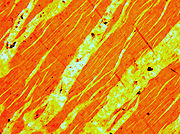
Perthite
Encyclopedia

Feldspar
Feldspars are a group of rock-forming tectosilicate minerals which make up as much as 60% of the Earth's crust....
s: a host grain of potassium
Potassium
Potassium is the chemical element with the symbol K and atomic number 19. Elemental potassium is a soft silvery-white alkali metal that oxidizes rapidly in air and is very reactive with water, generating sufficient heat to ignite the hydrogen emitted in the reaction.Potassium and sodium are...
-rich alkali feldspar
Alkali feldspar
The alkali feldspar group are those feldspar minerals rich in the alkali elements like potassium. The alkali feldspars include: anorthoclase, microcline, orthoclase and sanidine....
(near K-feldspar, KAlSi3O8, in composition) includes exsolved lamellae or irregular intergrowths of sodic alkali feldspar (near albite
Albite
Albite is a plagioclase feldspar mineral. It is the sodium endmember of the plagioclase solid solution series. As such it represents a plagioclase with less than 10% anorthite content. The pure albite endmember has the formula NaAlSi3O8. It is a tectosilicate. Its color is usually pure white, hence...
, NaAlSi3O8, in composition). Typically the host grain is orthoclase
Orthoclase
Orthoclase is an important tectosilicate mineral which forms igneous rock. The name is from the Greek for "straight fracture," because its two cleavage planes are at right angles to each other. Alternate names are alkali feldspar and potassium feldspar...
or microcline
Microcline
Microcline is an important igneous rock-forming tectosilicate mineral. It is a potassium-rich alkali feldspar. Microcline typically contains minor amounts of sodium. It is common in granite and pegmatites. Microcline forms during slow cooling of orthoclase; it is more stable at lower temperatures...
, and the lamellae are albite. If sodic feldspar is the dominant phase, the result is an antiperthite.
The intergrowth forms by exsolution due to cooling of a grain of alkali feldspar with a composition intermediate between K-feldspar and albite. There is complete solid solution
Solid solution
A solid solution is a solid-state solution of one or more solutes in a solvent. Such a mixture is considered a solution rather than a compound when the crystal structure of the solvent remains unchanged by addition of the solutes, and when the mixture remains in a single homogeneous phase...
between albite and K-feldspar at temperatures near 700°C and pressures like those within the crust of the Earth, but a miscibility gap is present at lower temperatures. If an alkali feldspar grain with an intermediate composition cools slowly enough, K-rich and more Na-rich feldspar domains separate from one another. In the presence of water, the process occurs quickly.

Microcline
Microcline is an important igneous rock-forming tectosilicate mineral. It is a potassium-rich alkali feldspar. Microcline typically contains minor amounts of sodium. It is common in granite and pegmatites. Microcline forms during slow cooling of orthoclase; it is more stable at lower temperatures...
K-feldspar. The intergrowths in perthite have a great variety of shapes. If cooling is sufficiently slow, the alkali feldspar may exsolve to form separate grains with near-endmember albite and K-feldspar compositions. The largest documented single crystal of perthite was found in Hugo Mine, South Dakota
South Dakota
South Dakota is a state located in the Midwestern region of the United States. It is named after the Lakota and Dakota Sioux American Indian tribes. Once a part of Dakota Territory, South Dakota became a state on November 2, 1889. The state has an area of and an estimated population of just over...
, US and measured ~10.7m x 4.6m x 1.8m.
The gem varieties of potassium feldspar, amazonite
Amazonite
Amazonite is a green variety of microcline feldspar.The name is taken from that of the Amazon River, from which certain green stones were formerly obtained, but it is doubtful whether green feldspar occurs in the Amazon area.Amazonite is a mineral of limited occurrence...
and moonstone
Moonstone (gemstone)
Moonstone is a sodium potassium aluminium silicate, with the chemical formula AlSi3O8.-Etymology:Its name is derived from a visual effect, or sheen, caused by light reflecting internally in the moonstone from layer inclusion of different feldspars....
are variant colored perthites.

